
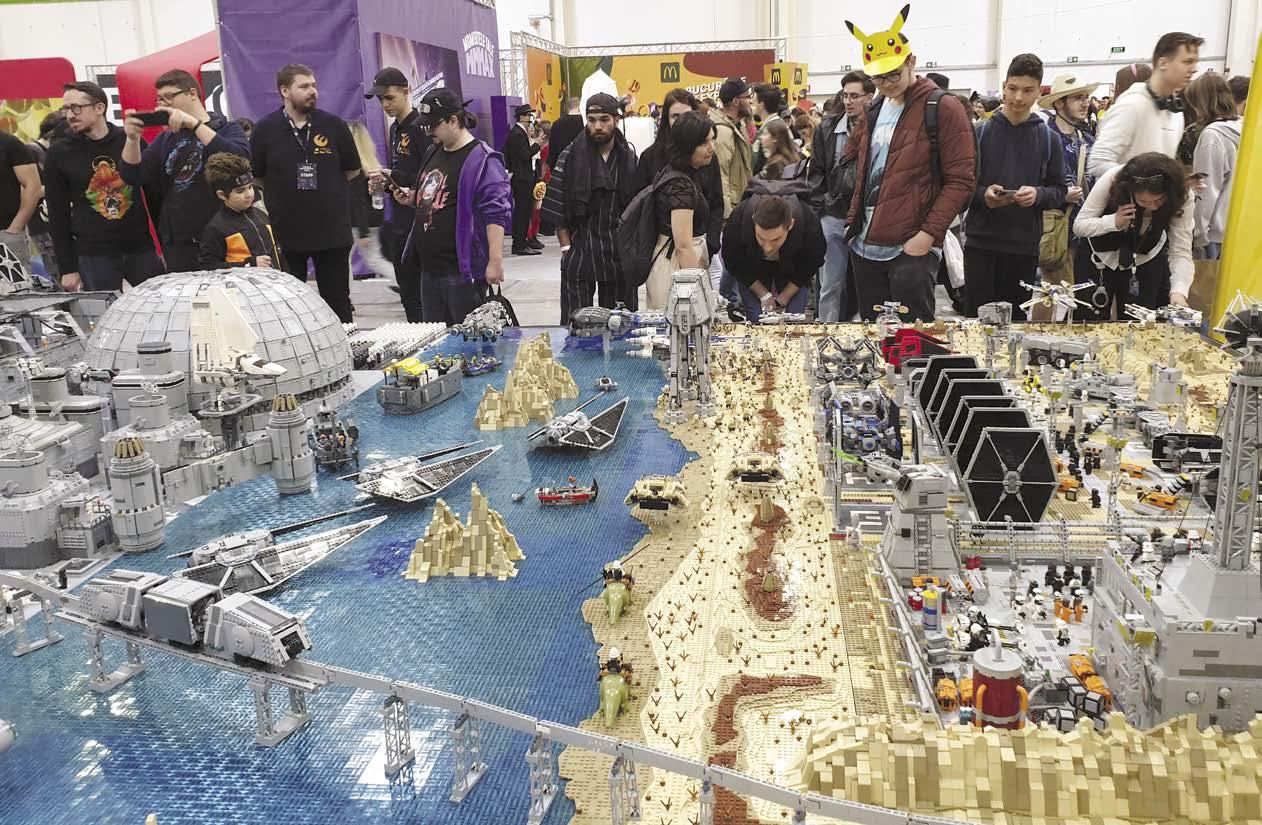
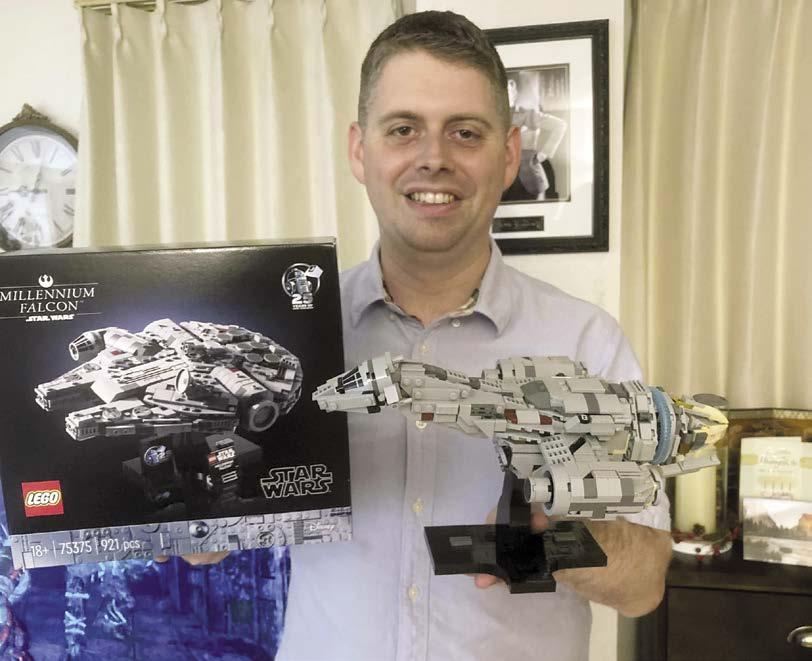




Brad Barber is a serviceman in the U.S. Navy stationed in Sasebo, Japan. He’s been building since he could remember, probably 1993. He built as a kid until around 2005, and start building again around 2014 when he saw all the new themes and better Ultimate Collector Series sets available. His favorite themes are Johnny Thunder and Insectoids.
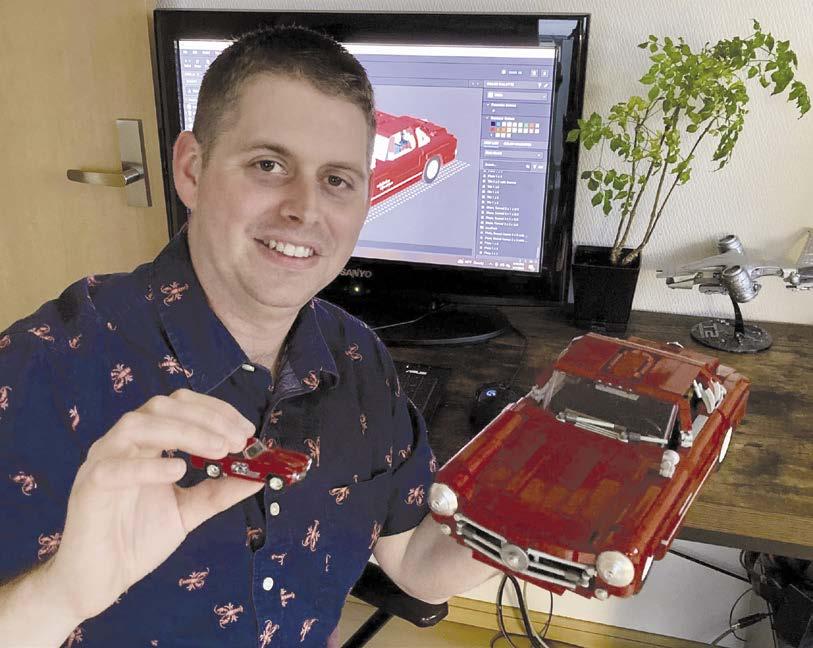
Brad Barber
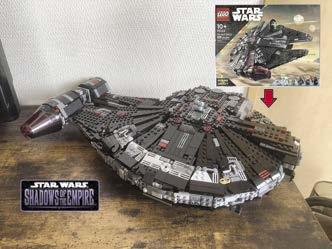
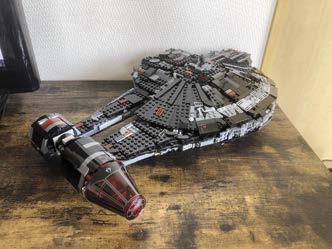

Brad started building MOCs when he thought it would be fun to see what he could create using only what came in a specific set. Being restricted on what pieces can be used really gets the creative juices flowing, and you can sometimes end up with better results when have to come up with a different solution, other than what could have been done with unlimited pieces.
Brad’s inspirations depend on what he is designing. He mostly started with the Batmobile, and then cars. Now the main focus has been MIDI-scale ships. Almost all of his builds are based off of something that already exists, so the challenge is to make the builds look as close to the original as possible.
On average, it may take a few days for Brad to make an actual build. Most of his time spent is building it in Bricklink Studio and taking pictures, filming
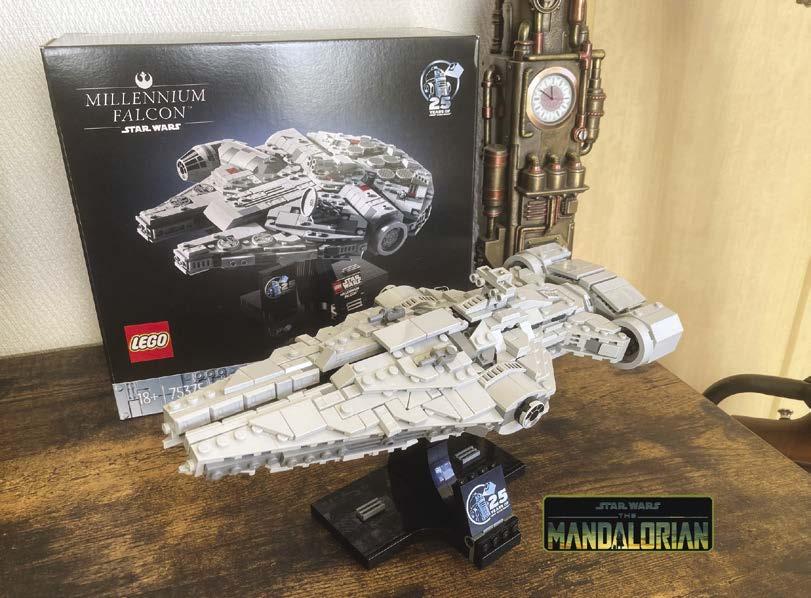
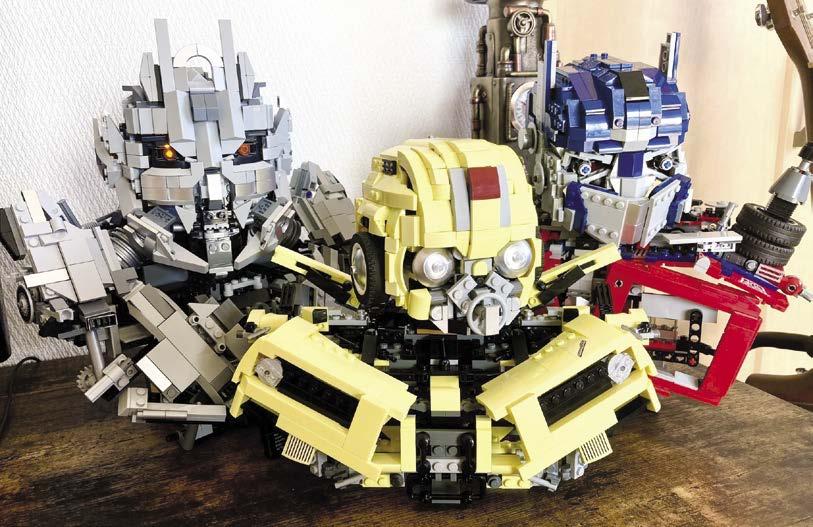
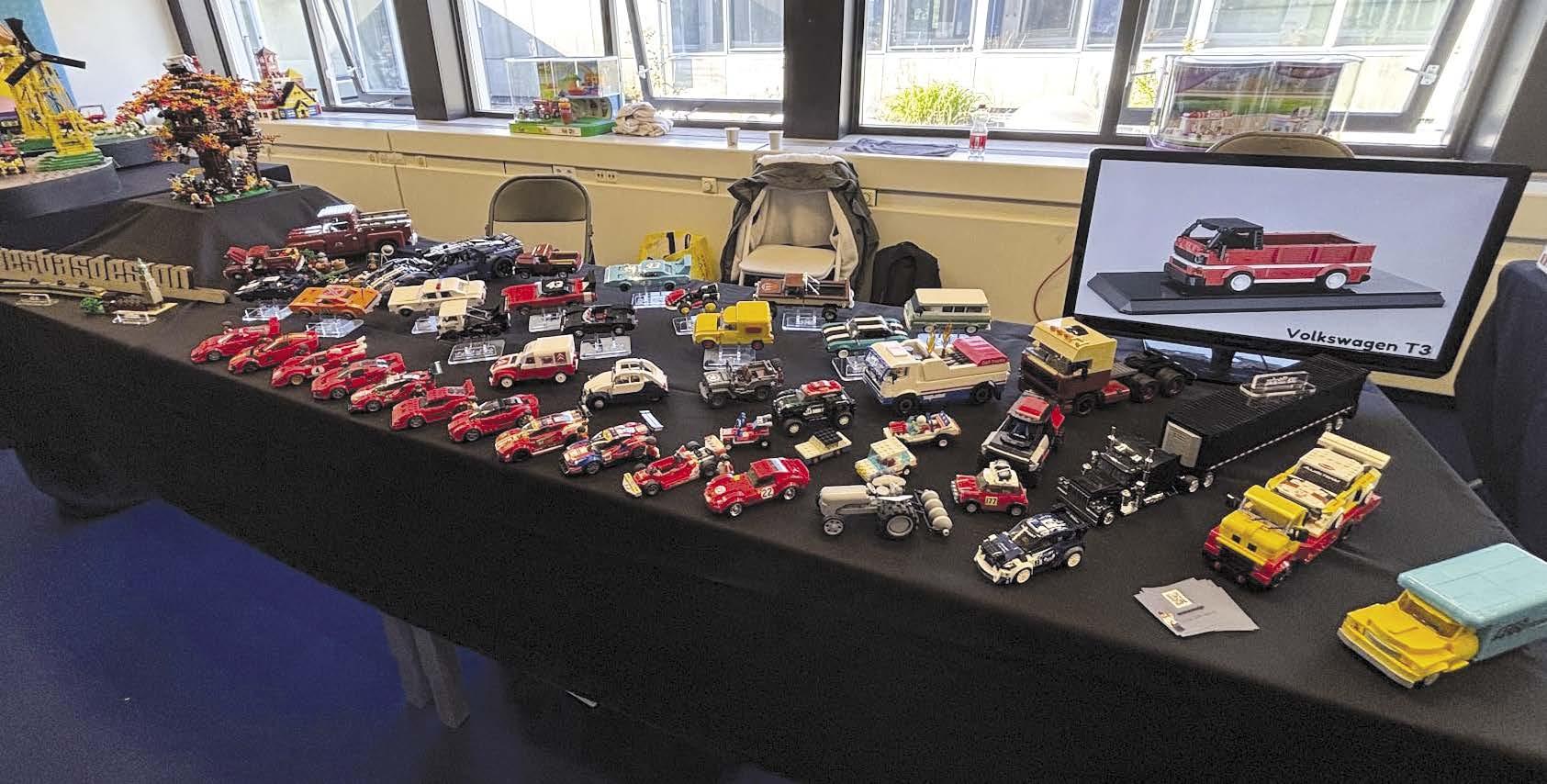
Jan van Laar is a secondary school teacher specializing in the Bouwen (building) Wonen (living) en interieur (interior) BWI program at the VMBO level (a Dutch system of preparatory secondary vocational education, typically lasting from ages 12-16). He teaches students a combination of practical construction skills and digital design, helping them prepare for careers in the building and interior sectors.
Article and Photography by
Jan van Laar
In his classes, students learn hands-on techniques, such as bricklaying, woodworking, and interior finishing. He also guides them through digital tools like SketchUp, teaching them how to design furniture, buildings, and interior spaces in 3-D. His aim is to connect traditional craftsmanship with modern technology, giving students a solid foundation for the future.
Jan lives in the Netherlands with his wife Joke and his two daughters Noor and Lien. Besides designing LEGO models, he also plays the tuba in an orchestra. In Dutch the tuba is called a Besbas, which is where his LEGO username, BesbasDesign, comes from.

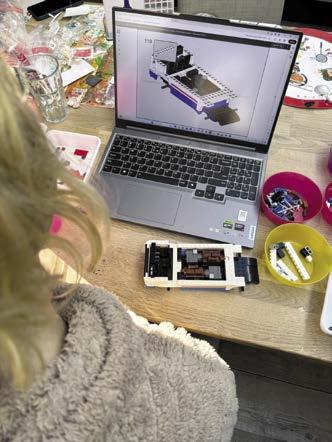

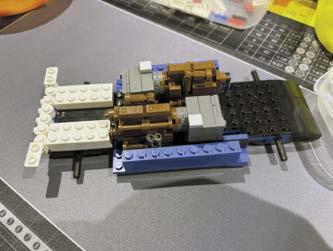
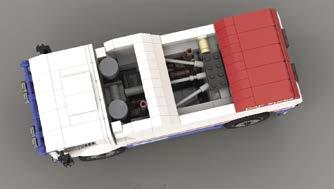
The MOC Jan is most proud of is his DAF Turbo Twin 95 X1. This is a Dutch rally truck powered by two engines, famously driven by Dutch rallycrosser Jan de Rooy in the Dakar Rally.
About the X1
• 1220 horsepower
• Top speed of 230 kilometers per hour on loose sand
• Equipped with three turbos per engine, including a turbo that precompresses air before it reaches the turbos on both engines
• Accelerates from 0 to 100 km/h in 7.8 seconds
• Weighs just over 10 tons
• Features aluminum rims and an aluminum space frame, reducing weight and increasing speed
• 940 liter fuel tank, necessary due to high fuel consumption
Jan built both engines into the model for added authenticity and detail.
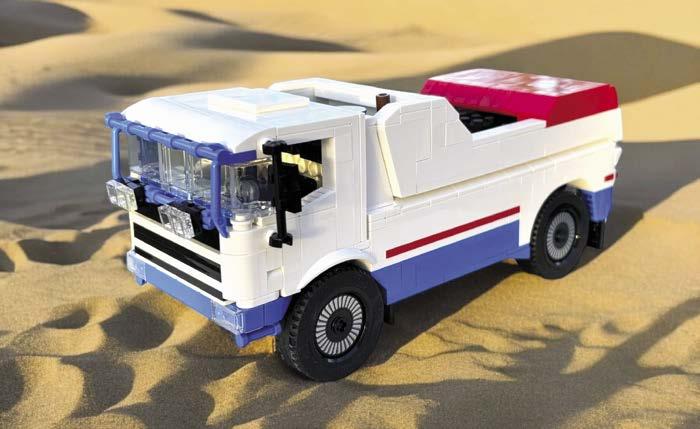

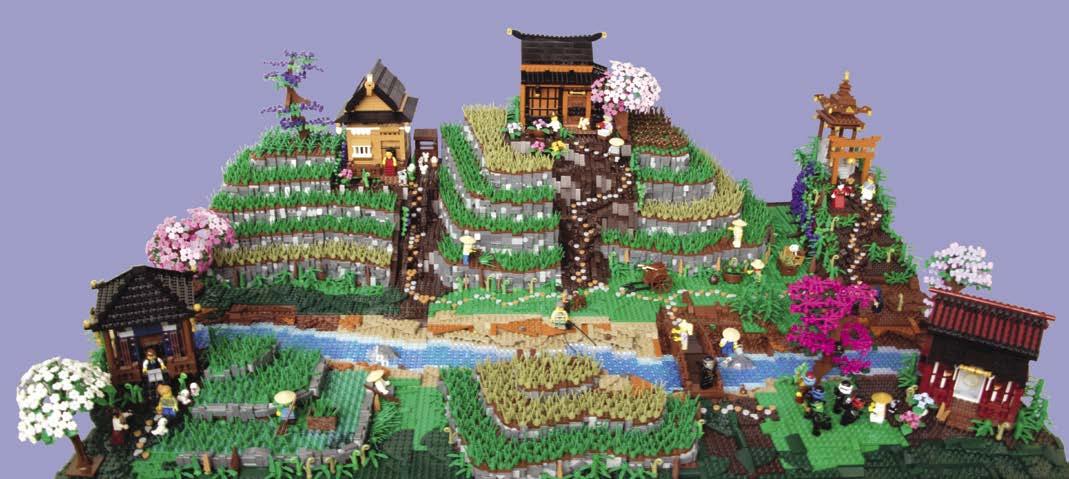
Photography
by Anu Pehrson
“What is your next project?”
is one of the first questions encountered by AFOLs with viewers.
“I’m thinking.” is my answer.
After finishing a MOC (My Own Creation), my LEGO room is always a mess. When freebuilding, I use a ton of parts to build or experiment with, so cleaning and reorganizing becomes a priority. Add all the new parts and sets that have been acquired to sort or build, and it becomes a place where my mind is working on what I am going to build next. I always have a ton of ideas stored away somewhere in the back of my mind or on a notepad.
I can’t speak for all builders, but I like to try something different for every new build. If not a completely different genre, then some new technique or new parts usage—something I’ve not done before, to expand my horizons a little.
So for my new MOC, I was very clear about one thing: it had to be small in comparison to my other projects.

(Parts can be ordered through Bricklink.com by searching by part number and color)
Qty Part Color Description
2 37762.dat Tan Cylinder 1 x 1.333 with 0.5L Bar and Bar Hole
3 4032a.dat White Plate 2 x 2 Round with Axlehole
2 3062b.dat Lime Brick 1 x 1 Round with Hollow Stud
6 5264.dat Black Plate 1 x 1 Round with Hollow Stud and Underside Clip
2 24201.dat White Slope Brick Curved 2 x 1 Inverted
1 85861.dat Pearl Gold Plate 1 x 1 Round with Open Stud
2 3038.dat Md Lavender Slope Brick 45 2 x 3
1 3622.dat Brick 1 x 3 Yellow
2 5404.dat Dk Turquoise Slope Brick 18 2 x 1 x 0.667
8 5404.dat Dk Brown Slope Brick 18 2 x 1 x 0.667
2 54200.dat White Slope Brick 31 1 x 1 x 0.667
2 30367c.dat White Cylinder 2 x 2 with Dome Top with Axle Hole and Hollow Stud
4 41682.dat Red Brown Bracket 2 x 2 - 1 x 2 Up Centred
1 18980.dat White Plate 2 x 6 with Two Rounded Corners
2 3460.dat Dark Turquoise Plate 1 x 8
1 37775.dat Trans Orange Minifig Candle Flame
1 3504.dat White Wedge 2 x 5 Straight Left
1 32474.dat Red Technic Ball Joint with Axlehole Blind
1 63965a.dat White Bar 6L with Thick Stop
1 35470.dat White Plate 3 x 5 Cloud Shape with 3 Studs
2 15712.dat Pearl Gold Tile 1 x 1 with Clip (Thick CClip)
4 20482.dat Yellow Green Tile 1 x 1 Round with Pin and Pin Hole
1 3505.dat White Wedge 2 x 5 Straight Right
1 43722.dat White Wing 2 x 3 Right
2 3709b.dat White Technic Plate 2 x 4 with Holes
4 3034.dat Red Brown Plate 2 x 8
2 5852.dat White Brick 2 x 2 x 0.667 Quarter Circle with Curved Top
1 47905.dat Lt Bluish Grey Brick 1 x 1 with Studs on Two Opposite Sides
5 78257.dat White Plate 1 x 1 with Handles on Opposite Ends
9 78329.dat Med. Nougat Plate 1 x 5
1 78329.dat White Plate 1 x 5
4 3069b.dat Dk Turquoise Tile 1 x 2 with Groove
4 85984.dat White Slope Brick 31 1 x 2 x 0.667
2 52107.dat Red Brick 1 x 2 with Studs on Sides
8 1871.dat White Brick 1 x 1 x 1.333 Round Quarter Dome with Curved Top
1 43723.dat White Wing 2 x 3 Left
4 32803.dat White Slope Brick Curved 2 x 2 Inverted
1 76307.dat Black Technic Flex-System Hose 5L (100LDU)

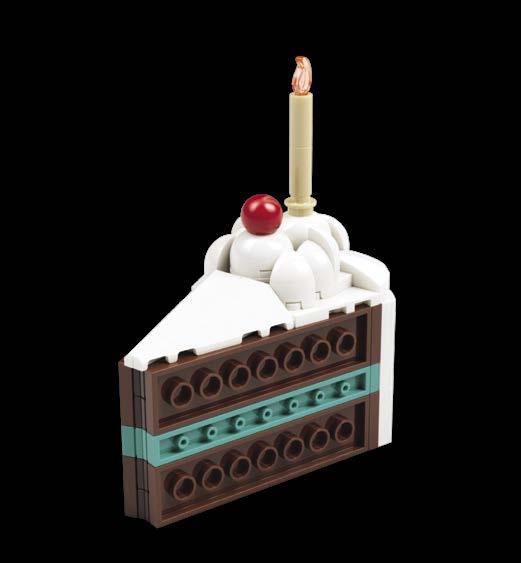
Who doesn’t love cake, especially when it’s made from tasty-looking LEGO? Inspired by the many creative cakes built by the LEGO community over the years, the BrickNerd team decided it was time to whip up our own sweet treat in honor of BrickJournal’s 20th anniversary.
First off, you’ll notice that the mirrored sides of the cake are made with the bottom of LEGO plates, showing off the tubes to evoke a wonderfully fluffy texture and crumb. The same technique replicates the look of some delicious teal frosting between the chocolatey layers, with some new 2x1 slopes to close the gap at the front of the cake.
Up top, the frosting is piped using pointy Speed Champions slopes and several of the newer 1x1 curved corner slopes, creating a swirl of icing that’s almost good enough to eat. And of course, no birthday cake would be complete without a candle to top it all off, ready for you to make a wish!
We hope you enjoy building this slice of cake as much as we enjoyed baking it up. Now grab your pieces and get ready to build and celebrate—no forks required!

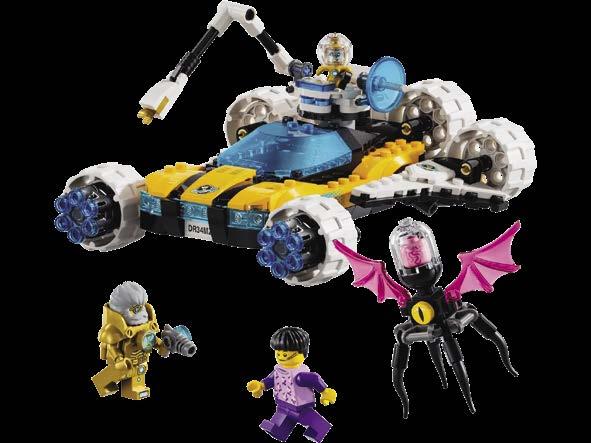
Alternates by Nathanaël Kuipers and Joe Meno
Way back in the beginning of this magazine, one feature that regularly appeared was the alternate build. A LEGO set was selected, and new models were created with only the parts in the set. The builder who did them was Nathanaël Kuipers, who completed several sets until he got hired by the LEGO Group.
Since then, Nathanaël has designed Technic sets, and gone on to other pursuits. For the 20th anniversary of BrickJournal, he was invited to do another alternate build, and he invited editor Joe Meno to join him.
The set selected is from the LEGO DREAMZzz theme and has a diverse set of parts to work from. It’s kind of a car with an alt aircar build, but the idea was to come up with completely different builds. Take a look and see what we came up with, and think about what alt builds you can create with a set!

Joe built what he likes to build: a plane. The number of wing plates lent itself to making something that flew, like the original set. The orange parts were used to get away from the car chassis. Leftover parts were used to refurbish the car into a refueling cart.
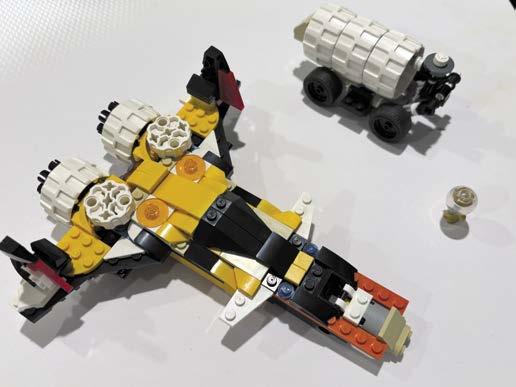

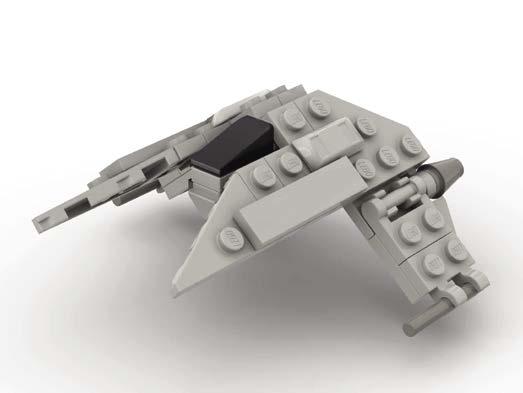
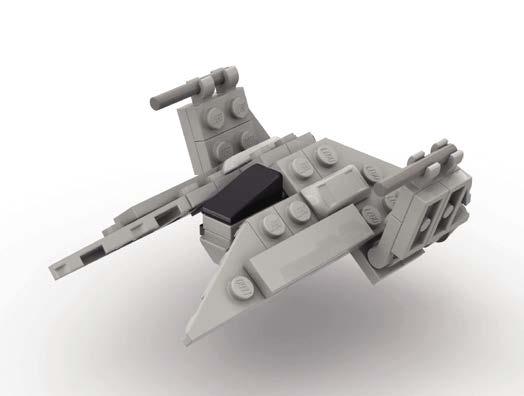
by Christopher Deck
Hello everybody, and a special welcome to this jubilee building session! Over the last twenty years we have built dozens of mini models together, and many of them come from the Star Wars universe. This is what I enjoy most, and it’s also what many readers want to experience most, so we will gladly continue with that! I also tried to keep you up-to-date with new ships appearing within the numerous new media content from the Star Wars universe.
Today, we will have a look at a new shuttle type which first appeared in the live-action series Kenobi and also was seen recently in the animated series Tales. We’re talking about the Phi-class shuttle, a vessel used by Imperial Inquisitors of the Galactic Empire. The “Scythe” was a vessel of this class. The Phi-class shuttle is similar to the Delta-class T-3c shuttle, as seen in spin-off film Rogue One. The Phi-class is a little wider and flatter than the Delta-class, the top fin is missing, and the side wings have been shortened. However, the remarkable pyramidal main section can be seen in both shuttle types.
This pyramidal multi-angle-design is also what makes it so tricky to build. The stubby prongs of the original Delta-class design now are a lot longer for the Phi-class, and revealing that the gap beneath them actually is wedge-shaped. We will realize this in our model by angling side-panels which end with the new pointed wedge plates (parts 65426 and 65429). Both angled side-panels sit safely on two of the new 1x1 roof-top slopes (part 35464). Finally, you will use a convenient way to obtain the closing pyramid face at the rear of the ship,
by adding a new 2x2 corner plate (part 26601) on an angled 1L bar (part 65578), which most of you will know from the Collectible Minifigure sets.
When you finish the model, you will have used many new parts of recent years, combined with traditional building techniques. The outcome is a really nice looking shuttle with a compact construction, containing 47 pieces, and—as usually—functional details for the fold-up wings. I hope to see you along our ongoing journey in BrickJournal, building many more models in many more years!
Parts List (Parts can be ordered from Bricklink.com by searching by part number and color)
Phi Shuttle Main Body
Qty
1 Lt-Bluish-Gray 36840.dat Bracket 1 x 1 -1 x 1 Up
1 Lt-Bluish-Gray 87087.dat Brick 1 x 1 with Stud on 1 Side
1 Lt-Bluish-Gray 52107.dat Brick 1 x 2 with Studs on Sides
2 Dk-Bluish-Gray 3937.dat Hinge 1 x 2 Base
1 Dk-Bluish-Gray 6141.dat Plate 1 x 1 Round
1 Lt-Bluish-Gray 65578.dat Plate 1 x 1 Round with Angled Bar
1 Lt-Bluish-Gray 3710.dat Plate 1 x 4
1 Lt-Bluish-Gray 26601.dat Plate 2 x 2 without Corner
1 Black 5404.dat Slope Brick 18 x 1 x 0.667
1 Lt-Bluish-Gray 54200.dat Slope Brick 31 x1 x 0.667
2 Lt-Bluish-Gray 35464.dat Slope Brick 45 x 1 Double
“I Never Made a Mistake in my Life. I Thought I did Once, but I was Wrong.”
— Charles M. Schulz
Article by Jared K. Burks
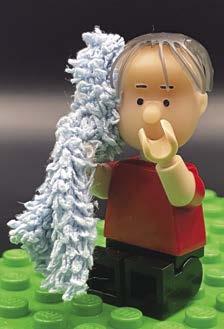


Well, this is the 20th anniversary issue of BrickJournal; can’t phone it in on this article, yet I have the same title as last time—what is happening here? I had a great time and am blown away at how Charlie Brown turned out, and I wanted more (and I hope you did, too). I also decided for the 20th that I would throw in some specific brick-built accessories to make this one a bit special, and that I would extend and expand upon what I showed and shared in the last article. While I am still focused on the beloved efforts of Charles M. Schulz, I am going further and presenting some things I learned and wanted to try after the first goround. So rinse and repeat! Just kidding. Let’s start with the background. Charles M. Schulz’s world of Charlie Brown simply spoke to me, as it did to so many, clearly. Charlie Brown was that young man who always came in second, had an interesting relationship with his dog and a football, and was infatuated with that Little Redheaded Girl. Charles M. Schulz was the American cartoonist and creator of the comic strip Peanuts. Last issue, I created a LEGO version of Charlie Brown, Snoopy, and Woodstock. Today I will share how to make Linus, Lucy, Schroeder, and Sally.
“Linus, my serious side, is the house intellectual, bright, well-informed, which I suppose may contribute to his feelings of insecurity.”
—Charles M. Schulz
A boy sitting down with a blue blanket, sucking his thumb.
Thoughtful and respectful, Linus is often the voice of reason among his peers. He is a deep thinker and a student of philosophy. Despite his run-ins with cantankerous Lucy, and the fact no one understands why he carries a security blanket, Linus remains delightfully hopeful. He’s certain that this year, the Great Pumpkin will appear… he just knows it…
Linus is Charlie Brown’s best friend, sounding board, and voice of reason. He is also Lucy van Pelt’s younger brother, and if you are familiar with Lucy, you know why Linus carries his security blanket everywhere. LEGO
“Lucy comes from that part of me that’s capable of saying mean and sarcastic things, which is not a good trait to have, so Lucy gives me a good outlet. But each character has a weakness and Lucy’s weakness is Schroeder.”
—Charles M. Schulz
Though she’s often dismissed as simply bossy or crabby, there’s more to Lucy than strong opinions. She dispenses sound advice for just five cents and looks out for her brothers, Linus and Rerun. She’s confident, strong, and positive she’ll make a great world leader one day. Lucy often speaks out for women’s rights and has high aspirations to one day be President and Queen. Her biggest weakness is her unrequited love for Schroeder… *sigh*. Never fall in love with a musician.
Although she often torments, teases, and belittles Charlie Brown, she is genuinely fond of him, and their true friendship is obvious throughout the strip. She is often the antagonist in a number of the comics, driving growth or exposure to novel experiences for Charlie Brown, even if she keeps him from succeeding by yanking that football away at the last moment.
LEGO Parts Needed:
Light blue torso with short sleeves
Light flesh arms and hands
Light flesh teen legs
Light blue dress (Alice in Wonderland CMS)
“Sally is the complete pragmatist. There is a certain charm when she fractures the language: ‘By golly, if any centimeters come in this room, I’ll step on them!”
—Charles M. Schulz
Sally is inquisitive and demands answers for everything. Why do kids have to go to school? Why not dessert first? When faced with a question she can’t answer, she tackles the problem with a classic philosophy: “Who cares?!” Her heart skips a beat when she sees her “Sweet Babboo,” Linus. And she knows that even though she may not understand him, she can always turn to her big brother, Charlie Brown, for help and encouragement. She’s the classic little sister who is too immature for her eight-year-old sibling, but she has a highly developed sense of what’s just, and cares deeply for her loved ones.
LEGO Parts Needed:
Light pink torso with short sleeves (Minnie Mouse CMS)
Light flesh hands
Light flesh teen legs
Light pink dress (Minnie Mouse CMS)
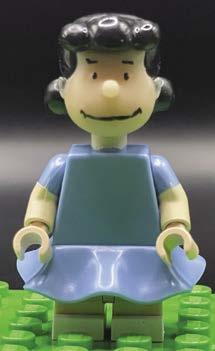
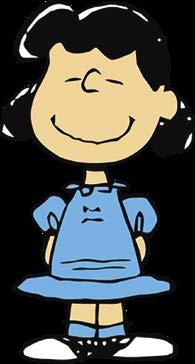


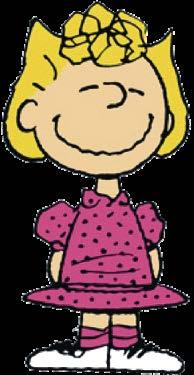
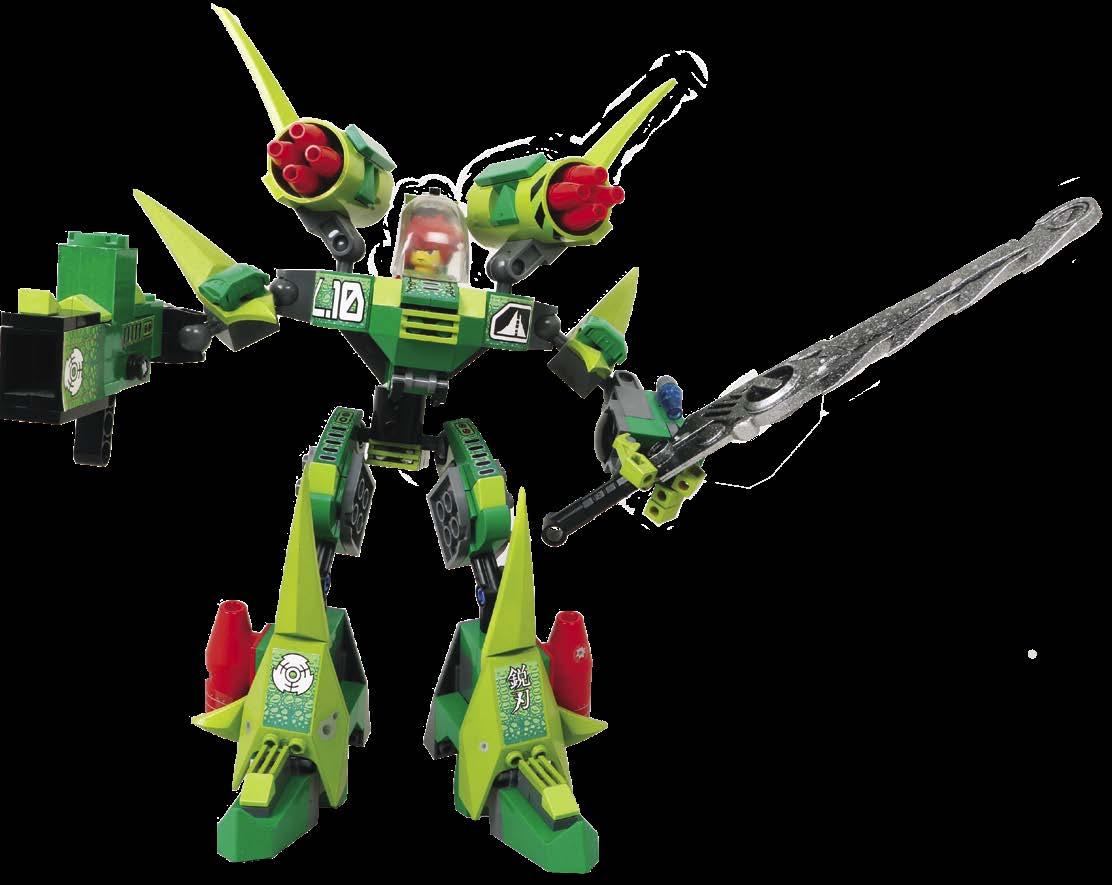
Article by Joe Meno
Photography by Mark Stafford
Here’s Mark’s sets on a timeline, spanning over 90 sets and growing!
Set information is compiled from Brickset.com.
Mark Stafford, one of the inital writers for BrickJournal, was hired by the LEGO Group, and has been on a journey with the company since almost the beginning of this magazine. BrickJournal was able to chat with him about his work and his experience building as a fan.
BrickJournal: How long have you been with company and what is your job title? What themes have you worked on?
On October 1, 2025, I’ve been a LEGO Designer for 19 years, though it doesn’t feel that long. Time really does fly when you’re having fun. It’s only when I look back at the sets I’ve designed and think of the changes in the way we work, that the passage of time comes into focus.
I started in 2006 building concept models for a theme called “Creature Capture” which never happened (though a couple of the vehicles did end up repurposed to capture dinosaurs in the “Dino” theme). Then in around my third month, I moved to the final year of Exo-Force where I designed my first LEGO sets: the Dark Panther and the Hybrid Rescue Tank. I also designed two other sets: a poly-bag mini set of a remote controlled ‘turtle’ robot with Hitomi, and a jungle clearing bad guy mech, but these were both cancelled after I was done, and while the building instructions were in development.

This is the first color version of the big T-Rex head, which shows how difficult shaping across colors can be.
I moved on to Mars Mission for a set, then Agents, Power Miners, Space Police, Atlantis, Alien Conquest, Ninjago, Legends of Chima and Nexo Knights, which gets us to 2017. Then I moved over to working on licensed themes: Jurassic World, Harry Potter, Overwatch, and Super Heroes which I started in 2019, and I’m still there as I write this. Along the way I’ve had a chance to make a couple of sets from LEGO Ideas vote winners: Peter Reid’s Exo-Suit and Lucas Bolt’s Dungeons and Dragons: Red Dragon’s Tail.
What’s the last non-licensed theme you worked on?
Nexo-Knights, a cool futuristic/tech twist on a castle theme. I really enjoyed the theme and built some cool vehicles and buildings, but I missed out on its final months because I spent six months on a massive complex postapocalyptic Batmobile for The LEGO Movie 2. This was cut from the final movie after I was done, so the set was cancelled. You never really get used to that happening!
When did you go from non-licensed to licensed, and how is that different in terms of designing a set?
When Nexo-Knights ended, it was like the end of an era for the team working on it. We’d been loosely together since Exo-Force (arguably some of the members since Alpha Team), with myself and a couple of other core people sticking around and a growing team around us. By the time we got to NEXO-Knights, we thought we had nailed how to approach the LEGO “Big Bang” themes. But with our growing attitude of “we tried that before and it worked (or it didn’t work)”, I think the worry was we were at risk of stagnation, and we know new kids need exciting new products! So a new team of designers took over for Monkey Kid and Dreamz. Some of us went to Overwatch and then stayed on for our new video games licenses; others like me moved on to work on the reboot of Harry Potter and Jurassic Park/World.
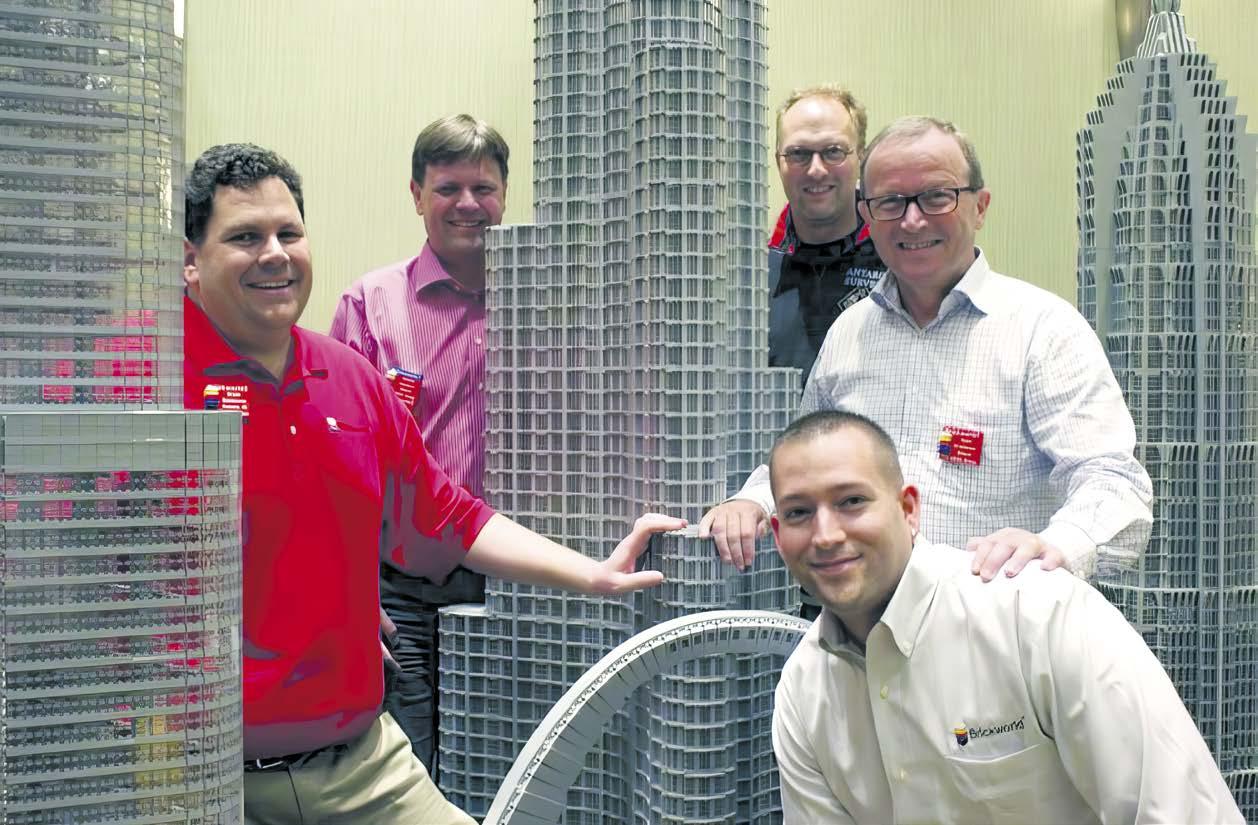
With BrickJournal reaching its 20th anniversary this year, it’s fitting to take a look back at its beginnings. One of the people that was responsible for the magazine is Tormod Askildsen, who retired from LEGO in 2022. Without him, BrickJournal probably would have been an online publication that would not have gotten the attention of the LEGO Group and readers around the world. It wasn’t a hard choice to contact him and talk about his career at LEGO and involvement with the LEGO fan community.
BrickJournal: So where and when did you start at LEGO?
Tormod Akildsen: I started at the LEGO Group in the Billund HQ back in 1983. I was fresh out of business school and was lucky to get a Marketing Trainee position. That took me around to several different departments, from marketing over purchasing to production planning and sales, during my first two years.
When did you start getting interested in LEGO fans?
That was much later. After around ten years in LEGO Education, I got the opportunity to look for new business opportunities in the educational/ childcare space. It eventually led me to digging into learning materials and trying to find something, which kids actually would find interesting and fun. We developed a learning philosophy and activities based on what kids (and parents) told us they would find challenging and fun. Realizing that our learning philosophy would likely not work well for classrooms, we decided to focus on home learning. The outcome was LEGO Mindstorms. When we released the LEGO Mindstorms product in the fall of 1998, we quickly saw that most products were purchased by adults who used it for hobby and prototyping purposes. That intrigued me quite a lot, and sent me on a journey with adult LEGO fans for the next 20 years.

I got into the hobby in 1999 with the Star Wars sets. By that time, LUGNET just started. At that point, you were involved with FIRST® (For Inspiration and Recognition of Science and Technology, a robotics competition) LEGO League. Can you tell me a little about that?
Peter Eio, our president for LEGO Americas, had a relationship with Dean Kamen through sponsorship of his newly started Robotics program. Dean founded FIRST® to stimulate young people’s interest in technology, science and engineering. Around 1996, Peter Eio told Dean, in confidence, about the work we had going with MIT Media Lab to create a learning product centered around autonomous robotics. Dean took a trip to Billund to meet with the LEGO Mindstorms team and suggested that we should form a “little league” together, using the LEGO Mindstorms technology and the FIRST network of volunteers. We did. I had the honor to work with FIRST president Andy Allen (a former NASA astronaut), and we hired Anna Maenhout to head up the creation and operation of the program, which we called FIRST® LEGO League. We did a pilot test with some prototypes during the FIRST Completion at Epcot in 1997, and launched the program at the Museum of Science and Industry in Chicago in 1998. Our fundamental belief when creating the FLL program, was that if kids are given quality materials and a hard challenge, they would be motivated
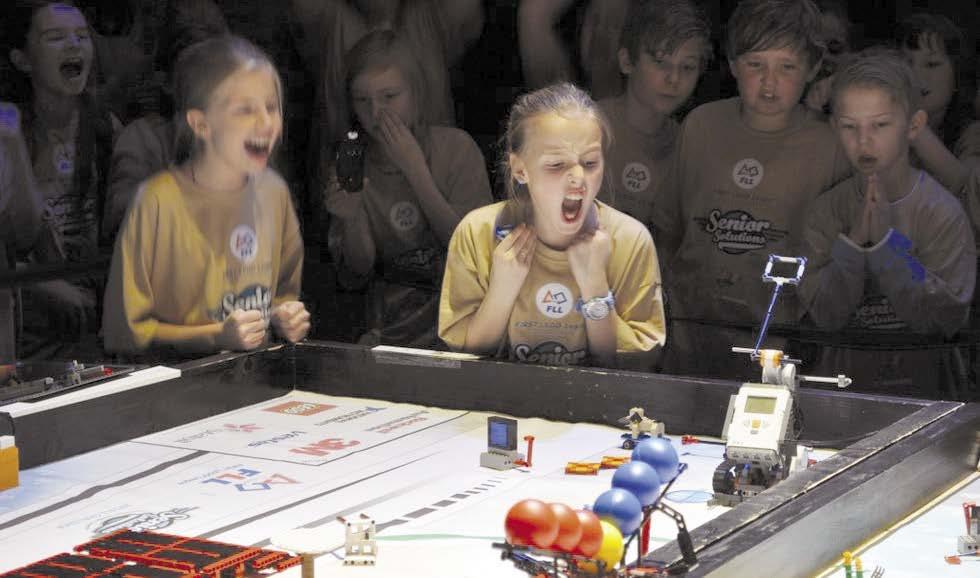
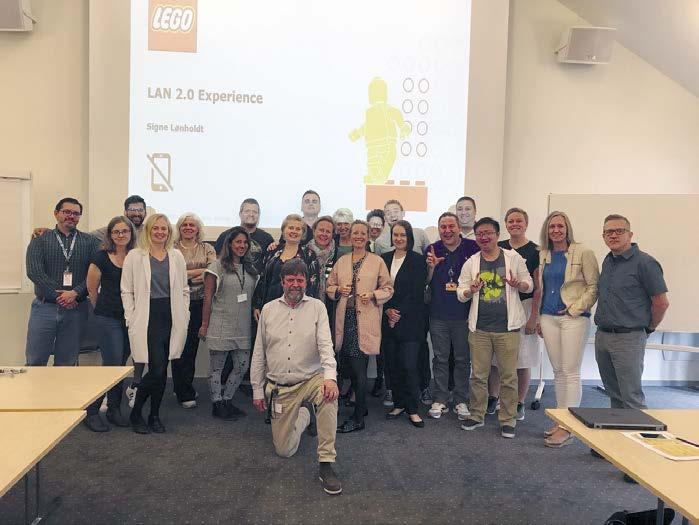
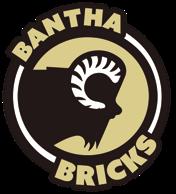

Galactic greetings! We are Bantha Bricks: Fans of LEGO Star Wars. As administrators of one of the best LEGO Star Wars themed groups on Facebook, David Strenzler, Frank Averstegge, Eloi Parizeau and Steven Smyth witness amazingly creative builds by Star Wars fans worldwide on a nearly daily basis.
This time we are thrilled to introduce you to our community members Botond and Bence Czilli from Romania. Representing their 26-member team from the RoLUG (Romanian LEGO Users Group), both David Strenzler and Steven Smyth talked to father and son about their officially recognized and certified Guinness World Record™ for building the largest LEGO brick diorama.
For the almost 46 square meter LEGO Star Wars landscape, the team was inspired by the animated series Star Wars Rebels and used more than one million LEGO pieces, over 1000 Minifigures, and built no less than 200 spaceships to represent the planet Lothal.
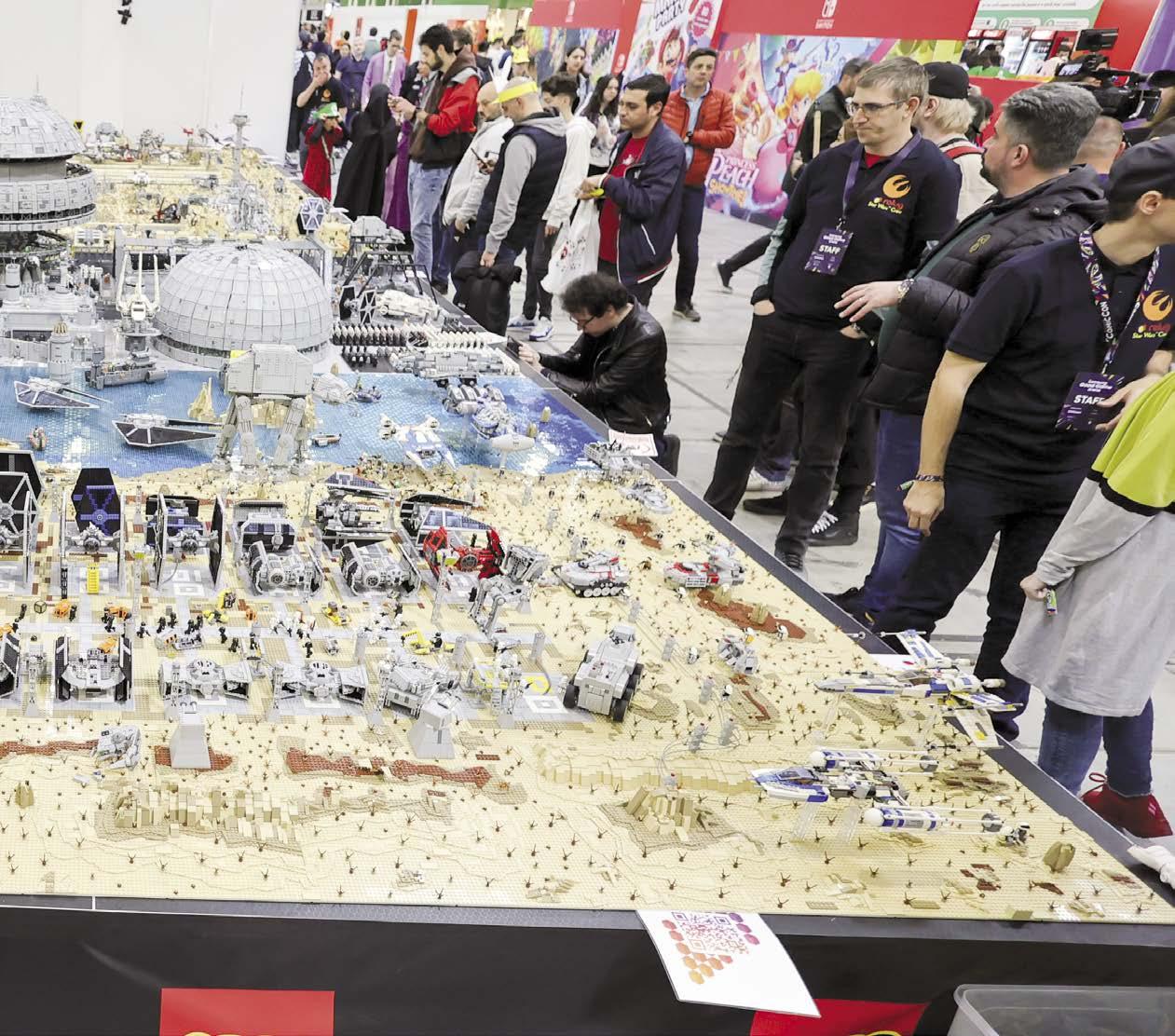
David Strenzler: Hello Botond, hello Bence. Welcome to the Bantha Bricks Files! The LEGO Star Wars community has been familiar with your skilled Star Wars-inspired designs for some time. Could you please introduce yourselves and what you do?
Botond Czilli: Hi everyone, it’s so nice to meet you! I’m Botond, a freelance graphic designer and a LEGO addict.
Bence Czilli: Thank you for reaching out to us for this interview. Although I’m still studying, LEGO is an important part of our lives.
In the rest of my free time when I’m not building sets and MOCs, I like to immerse myself in the world of animals and nature.
D.S.: Would you say that Star Wars is your favorite theme, or are there others that we might not expect?
Botond: Star Wars leads, there is no question about it. But as a child I had two smaller Blacktron I sets; so that theme will always be close to my heart. Besides these, I really like the medieval and fantasy themes. Unfortunately, we do not have too many sets from those, nor did we create any MOC worth mentioning (yet).
Bence: Close to Star Wars is my love for the Space theme. On top of that, I have a fondness for the Architecture series and Modular buildings in general.
D.S.: Why have you chosen the LEGO brick as your medium of self-expression? What makes LEGO so special to you?
Botond: For me, it’s the best father-son bonding experience building together with Bence; I wouldn’t trade it for anything in the world.

For the 20th anniversary of BrickJournal, we’ll be reprinting some of the articles from past issues. This particular article is noteworthy because it showcases the work of a designer that later went on to be a host of the LEGO Masters show in the US!
This interview was from the online edition of BrickJournal and could be found in print only in BrickJournal Compendium 3. It originally appeared in issue #7 of the online edition, dated Spring 2007.

We are pleased to present an interview with the designer of the Café Corner Set, Jamie Berard. Before he became a LEGO set designer, Jamie was an AFOL –and one can tell with the models he has designed both in the company, and outside for fun. Here he takes us behind the scenes of creating this set.
BrickJournal: What’s your background as a LEGO Designer?
Jamie Berard: I’ve been with the LEGO Company for just over a year now. My big break came at BrickFest 2005 where I met with lots of LEGO representatives and ended up getting hired shortly thereafter. My background is a bit atypical for a LEGO Designer considering that I’ve been a carpenter, surveyor, video editor and monorail pilot. The one thing that has always been a constant is my passion for the Brick.
I am still a proud member of the New England LEGO Users group and have been a member of the LEGO Club since I was four. Fortunately, I never had to go through the Dark Ages that so many other adult fans have gone through. For me, LEGO has always been cool.
How did the concept for the Café Corner come about?
Back in early 2006, my creative lead in Creator approached me to see if I’d be interested in building a model for LEGO Direct. Jan Beyer and Steve Witt had polled the AFOL community and determined that fans really wanted houses and buildings—and lots of them! Since I was the in-house adult fan who had just finished up working on a bunch of buildings for the Millyard Project, the powers that be found me a perfect match for the project. Since I had only done
a $20 airplane up until that point (insert shameless plug for 4953 Fast Flyers), the idea of a $100+ project really presented me with a fantastic challenge that I was eager to tackle.
My first idea for a modular building system came from my appreciation for the old castle system, and more recently for the moon base module system. I am fascinated by the idea of snapping together different sections to create an ultimate castle or space station. To take that type of thinking and apply it to buildings seemed like a sure-fire way to begin a method of modeling that can be continued and built upon for many years to come. Plus, with just a few set standards, there’s the potential of introducing the fan community to another way of coming together to display at the many fan events around the world.
To establish the basis of the system, I ran my ideas by 25-year veteran designer Steen Sig Andersen—who actually worked on many of the 1980s castle products. We sat down for a couple of hours and came up with the current simple connection points that will now be the basis for all buildings going forward.
You say “going forward.” Is this the beginning of a series of products? Hopefully. LEGO Direct views the modular building system as a line of products which they would like to continue investing in for more than this year. Of course, sales will ultimately determine how long the line will last. So, if you like it, please buy the Café Corner to show you want more products to go with it in the future.
I’ve already finished the sketch of the potential follow-up model. I’d love to see it make it to market.
Any hints as to what that one will look like?
It’s a very cool building that I already want to buy four of.
Were there any challenges you faced in developing the Café Corner?
Oh, you betcha.
Besides the initial issues I had with convincing others that this idea in my head was worth buying into, there were several more challenges which popped up during the development cycle.

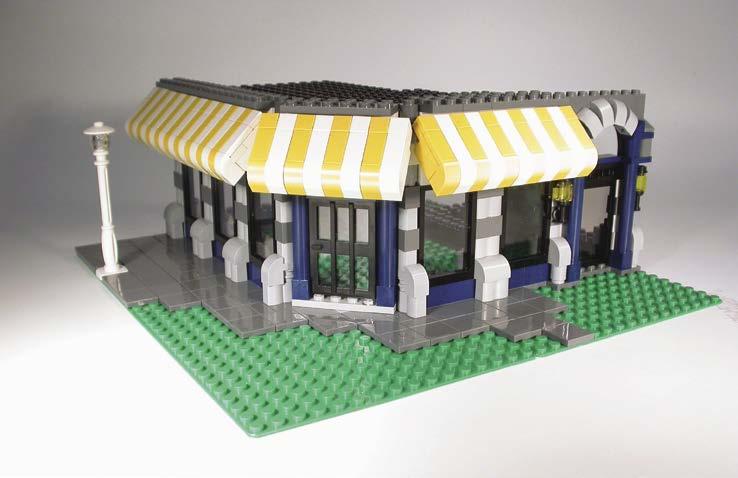
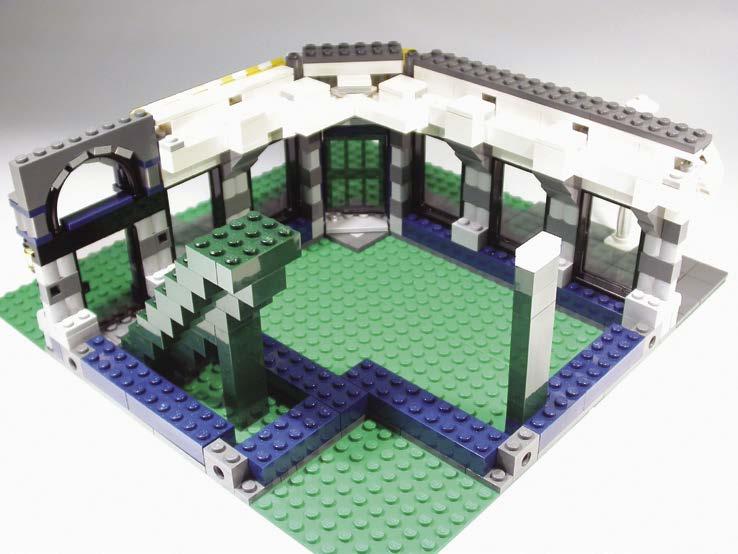
Article by Jette Orduna
Photography by Joe Meno
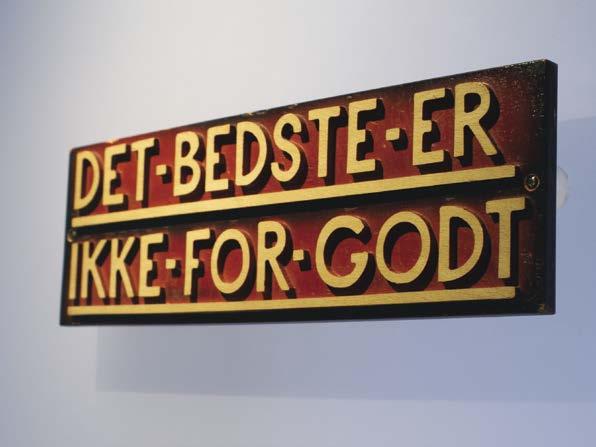
the best is good enough,” is on a wood sign that was in the old LEGO
This article was first published in BrickJournal #4, dated Winter 2008. LEGO House, the LEGO public museum in Billund, Denmark, was opened in 2017. The LEGO Idea House is a private museum open to employees and guests.
A few months back, Jesus Diaz, a journalist at gizmodo.com, visited the LEGO Idea House, and his report was an emotional description of what often happens when people visit the LEGO Idea House.
“It really only takes a reminder—the little image, story, piece of video, whatever it is—to send people back to the thing that makes LEGO unique to every child who plays with it: the hardwire connectivity it has to the heart and emotions. LEGO is the raw material that represents every carefree hope and dream of every child.“
Some of the feedback from the article was: ”It makes me remember a simpler, happier time”. “It takes me back to my youth”. “It makes me teary”. “I had forgotten about LEGO and didn’t care anymore until I read your post”.
For the LEGO Group, however, the primary target group of the Idea House is their employees. They must know the very special LEGO culture, its unique story, and that, in combination with a strong brand (the brick) that the LEGO Group has long been a value-driven company, even before it became fashionable.
“Our idea has been to create a toy that prepares the child for life—appealing to its imagination and developing the creative urge and joy of creation that are the driving force in every human being.” — Godtfred Kirk Christiansen, 1955
The story of the LEGO Idea House goes back to the late ’80s, where Godtfred Kirk Christiansen (GKC) saw a need for a place to tell the story of the LEGO past, present and future, the product concept and philosophy, and LEGO attitudes and values. He and his son Kjeld Kirk Kristiansen made sure that an Idea House was integrated into LEGO Center, a building that now belongs to the Hotel LEGOLand.
YOU ENJOYED THIS PREVIEW, CLICK THE LINK TO
Because of the sale of LEGOLand Billund to Merlin Entertainment in 2004, the LEGO Idea House became homeless—but as it happened, not for long!
Kjeld and the LEGO Foundation offered a new home for the LEGO Idea House, and what a perfect place; the home of the LEGO idea and the home of the LEGO founder Ole Kirk Kristiansen.
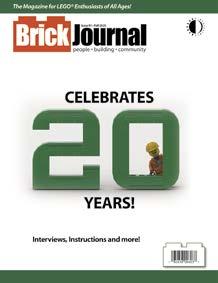
That turned out to be a challenge. We had to create a new, exciting and relevant LEGO Idea House in buildings where the story actually took place, in buildings that for many years had been LEGO Group offices, but also in buildings that were built for a very different purpose. We had to create a unique universe that would inspire our LEGO employees and guests to understand the LEGO idea and culture.
In January 2005, the LEGO Idea House moved into three connected buildings. First is Ole Kirk’s House on Hovedgaden (Main Street). The house dates from 1924, and was the family’s home and office during the early years of the LEGO Group. The wooden-toy factory was built in 1942 after a fire, and wooden toys were made here